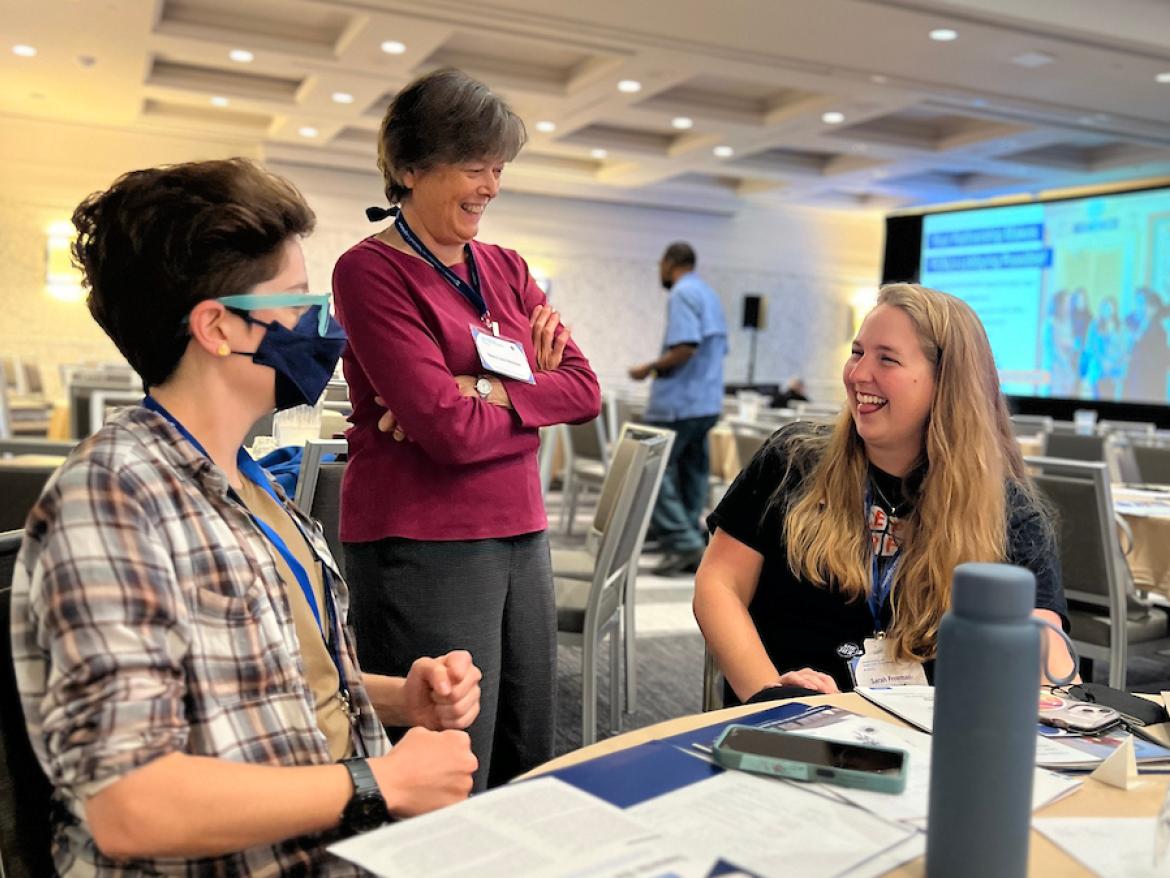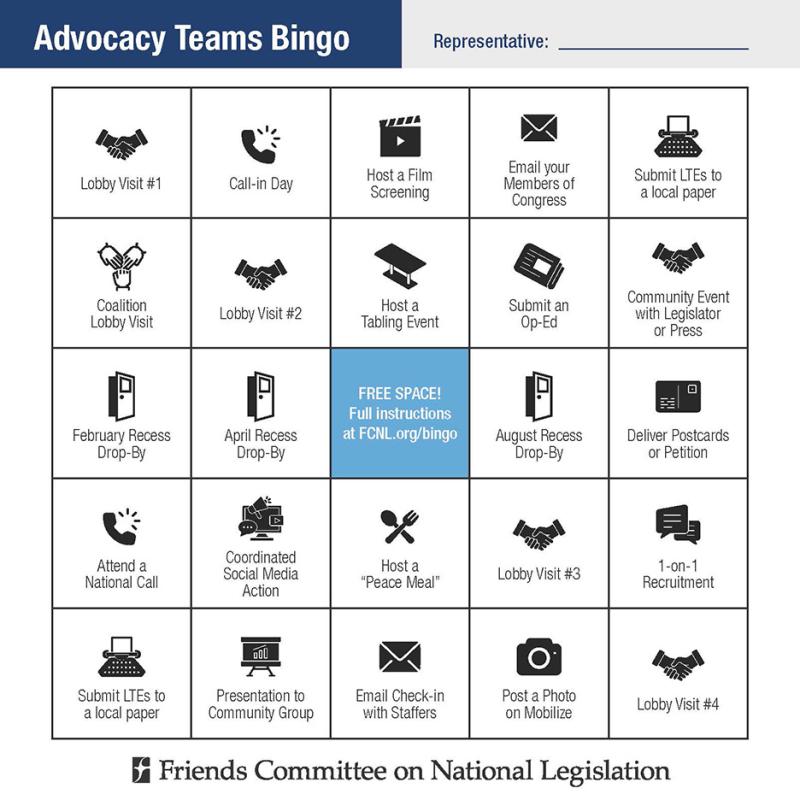Welcome to Advocacy Teams Bingo! The following bingo card and accompanying descriptions will guide your Advocacy Team through 24 powerful ways to create a more peaceful and just world.
Some of these actions are more challenging than others. Remember, if you get stuck, keep trying, but don’t hesitate to try something else in the meantime. To request support from Advocacy Teams staff, please reach out to advocacyteams@fcnl.org.
First Row (Left to Right)
- Lobby Visit #1: Request your first lobby visit with this office. Try to schedule it in the first quarter of the year: January, February, or March. Focus this visit on building a relationship with the office (if you do not yet have a relationship with the office). And focus on educating the office about our campaign for the year.
- *Call-in Day: Call each of your Members of Congress. Use the script provided.
- *Host a Film Screening: Invite members of your community to watch a film related to the legislative issue. Hold a discussion or an action afterward, such as writing a letter to their Members of Congress about our ask. If the event is in person, consider offering refreshments.
- *Email your Members of Congress: Using FCNL’s website, send emails to each of your Members of Congress. Tip: Personalizing your email helps your email stand out and is significantly more effective.
- Submit Local Focus Letters to the Editor from 3-4 Team Members: After your second lobby visit, write an LTE thanking or urging your members of Congress to support our ask. Be sure to tie in a local issue!
Second Row (Left to Right)
- Coalition Lobby Visit: Schedule a joint lobby visit with a group that works on an issue that intersects with our issue (attend each other’s visits).
- Lobby Visit #2: Request your second lobby visit with your member of Congress’s office. Try to schedule it in the second quarter of the year: April, May, or June. Focus this visit on asking the office to take a low-level supporting role: to read something or to vote in support. Also, invite someone in your community who holds influence or represents a different perspective—for example, a schoolteacher, clergy, or business owner—to join you.
- *Host a tabling event: Host a tabling event in your community. Request a tabling box by filling out this form at least two weeks before your event.
- Submit an Op-Ed: Getting an op-ed published is more difficult than getting an LTE published. It takes more work to write and is less likely to get published. However, op-eds have more impact. Consider submitting an op-ed after your second lobby visit. Connecting your op-ed to an upcoming holiday or news event is a good idea.
- Tip #1: Consider asking someone with influence in your community to submit your team’s OpEd to increase its chances of getting published.
- Tip #2: Consider asking the editor of your newspaper (or the opinion section) to meet with your team to build a relationship with the editor and learn what they value in opinion pieces. - *Community Event with Legislator or Press: Organizing an event in your community and inviting a member of Congress, congressional staff, or members of the press (holding a press conference) is a high-level action that your team can work towards. Consider the following as you plan your event: How can you clearly connect how a local issue in your community relates to our legislative campaign? Who can you invite who has influence to attend the event? What timeframe will make your event most impactful (a Congressional recess, the International Day of Peace, etc.)?
Third Row (Left to Right)
- February Recess Drop By: Congress will be in recess in February (check exact dates online), and members of Congress will be home in your state or district. Work with your team to find a time to drop by their local office with our campaign leave behind and ask for a few minutes to speak to the member or staff about our issue. Be sure to submit a lobby report if you talk to a staffer.
- April Recess Drop By: Congress will be in recess in April (check exact dates online), and members of Congress will be home in your state or district. Work with your team members to find a time to drop by their local office with our campaign leave behind and ask for a few minutes to speak to the member or staff about our issue. Be sure to submit a lobby report if you talk to a staffer.
- August Recess Drop-By: Congress will be in recess in August (check exact dates online), and members of Congress will be home in your state or district. Work with your team members to find a time to drop by their local office with our campaign leave behind and ask for a few minutes to speak to the member or staff about our issue. Be sure to submit a lobby report if you talk to a staffer.
- *Deliver Postcards or Petition: A great way to raise the profile of a legislative issue in your district or state is to speak directly with community members. Explain the issue you care about, invite them to write a postcard to their member of Congress, or sign a petition. Collect the postcards or signatures and hand-deliver them to your local Congressional office.
- Tip #1: Plan this action to coincide with a February, April, or August recess drop-by visit.
- Tip #2: Use this action as a recruitment opportunity by welcoming participants to join your team.
Fourth Row (Left to Right)
- Attend a National Call: On the first Wednesday of every month at 8:00 p.m. ET, hundreds of Advocacy Team members gather nationwide to learn from an expert speaker, receive a policy update from FCNL’s lobby team, and hear stories from teams nationwide. Be sure to attend this energizing highlight of the month every first Wednesday!
- Coordinated Social Media Action: The Congressional Management Foundation reports that when a half dozen constituents each comment on a social media post by a member of Congress within the same hour, it can cause a meeting to happen in the congressional office. This action requires coordination and quick action on the part of the team. To plan ahead, choose the hour of the day that most team members are available. Have someone on the team watch for a post by your legislator that connects with our ask. Once a post is chosen, get as many people on the team as possible to comment on the post. Remember to be respectful and comment in a way that builds the relationship while sharing a clear ask.
- *Host a Peace Meal: While the weather is nice, consider hosting a team picnic in a park or inviting the team over to a team member’s home for a meal. Meeting in person occasionally allows for deeper relationship-building and connection among team members. The “Peace Meal” may be for internal bonding only, or you may choose to invite others who may be interested in your work to meet the team.
- Lobby Visit #3: Request your third lobby visit with this office. Try to schedule it for the third quarter of the year: July, August, or September. Focus this visit on asking the office to co-sponsor the bill the Advocacy Teams are working on or make a public statement in support if the office has already co-sponsored the piece of legislation.
- 1-on-1 Recruitment: The core of a lobby visit is a short personal story connecting a value or experience we hold to the issue we are lobbying on. Did you know we can use our stories not just in lobby visits with congressional staff but also with people we encounter in our community? One of the most effective ways to draw others into our work is to speak with them one-on-one about our campaign. Be sure to have an “ask” as well: will you invite them to your next team meeting, to observe your next lobby visit, or to watch a film about our issue? You can also invite them to the next Intro to Advocacy workshop with FCNL.
Fifth Row (Left to Right)
- 3-4 Team Members Submit LTEs: Advocacy Teams have had great success in getting published when several team members submit unique letters to the editor with the same ask on the same day. Have one team member find an article in your newspaper that your team can respond to. Then, support one another to each write unique letters to the editor based on this article. Most importantly—and for the greatest chance of getting published—all team members should submit their LTEs on the same day. The more team members who can write, the better!
- Presentation to Community Group: Speaking to local community groups is a powerful way to educate your community and invite them to join you in your advocacy. What local clubs, interest groups, houses of worship, or community associations could you reach out to and ask to speak to? Remember to connect our legislative campaign to the core mission of the group you’re speaking to so they can understand how our issue connects with their values.
- Tip: Schedule a team action a few weeks after your presentation so you have something specific to invite new people to do. - Email Check-in with Staffers (4x per year): Follow-up is essential, and many groups who lobby congressional offices do not do it. To increase the likelihood of the office acting in response to your ask, put a reminder on your calendar to check in via email about six weeks after your lobby visit. Continue to build the relationship, politely share your ask again with the staffer, and ask what follow-up action has been taken on your ask.
Tip: In addition to checking in about the legislative campaign, consider building the relationship by sending a birthday card to the member of Congress on their birthday. Ask the staffer to pass the birthday wishes along. - Post a Photo on Mobilize: A photo is worth a thousand words! Advocacy Team members can inspire and energize one another by posting a photo of a recent team action on Mobilize in your state, regional, or national group.
- Lobby Visit #4: Request your fourth lobby visit with this office. Try to schedule it for the third quarter of the year: July, August, or September. Focus this visit on urging the member of Congress to talk with their colleagues about supporting our legislative ask.
* Please Note
All descriptions below are marked with an asterisk (*) are great opportunities for outreach to your community. When you do outreach, invite interested people to attend the next Intro to Advocacy workshop with FCNL and ask them to share their email and phone number with you, saying you will follow up with them after the workshop to invite them to your next team meeting or action.
Reminder
Remember to report all of your actions! Report lobby visits, media publications, and community events on the Advocacy Teams Toolkit.
Join our email list!
Stay informed and stay active

